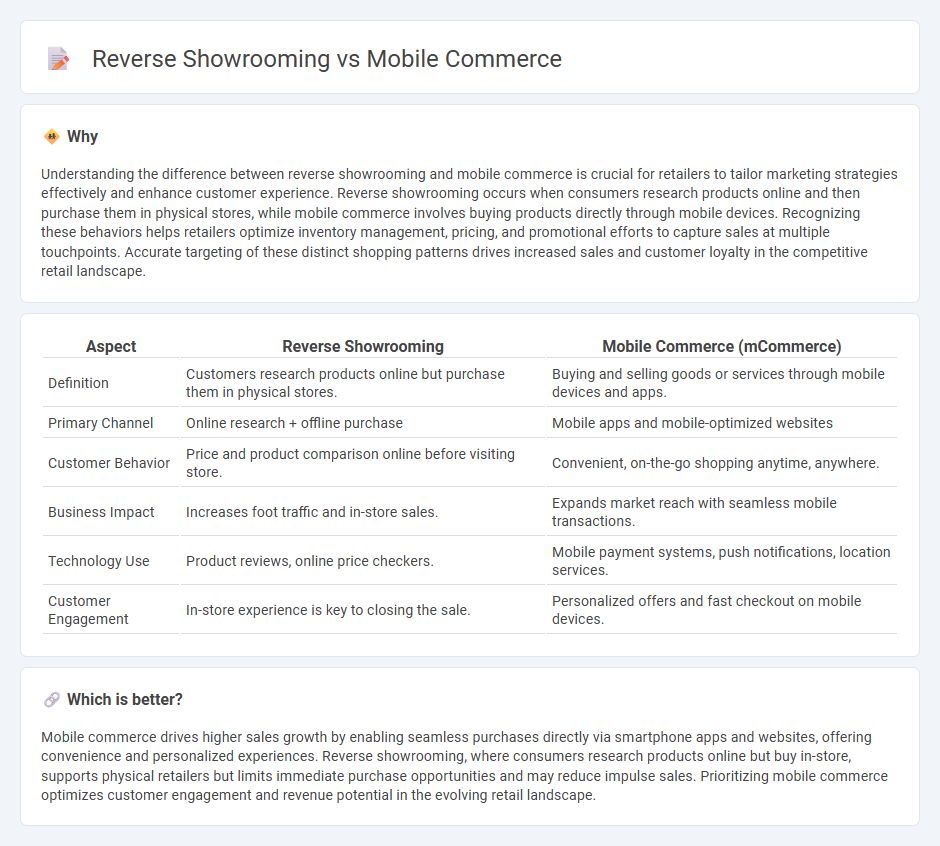
Reverse showrooming involves customers researching products online before purchasing them in physical stores, enhancing in-person shopping experiences with digital insights. Mobile commerce leverages smartphones and apps to enable seamless purchasing anytime and anywhere, driving convenience and personalization in retail. Explore how these trends reshape the retail landscape for innovative shopping strategies.
Why it is important
Understanding the difference between reverse showrooming and mobile commerce is crucial for retailers to tailor marketing strategies effectively and enhance customer experience. Reverse showrooming occurs when consumers research products online and then purchase them in physical stores, while mobile commerce involves buying products directly through mobile devices. Recognizing these behaviors helps retailers optimize inventory management, pricing, and promotional efforts to capture sales at multiple touchpoints. Accurate targeting of these distinct shopping patterns drives increased sales and customer loyalty in the competitive retail landscape.
Comparison Table
| Aspect | Reverse Showrooming | Mobile Commerce (mCommerce) |
|---|---|---|
| Definition | Customers research products online but purchase them in physical stores. | Buying and selling goods or services through mobile devices and apps. |
| Primary Channel | Online research + offline purchase | Mobile apps and mobile-optimized websites |
| Customer Behavior | Price and product comparison online before visiting store. | Convenient, on-the-go shopping anytime, anywhere. |
| Business Impact | Increases foot traffic and in-store sales. | Expands market reach with seamless mobile transactions. |
| Technology Use | Product reviews, online price checkers. | Mobile payment systems, push notifications, location services. |
| Customer Engagement | In-store experience is key to closing the sale. | Personalized offers and fast checkout on mobile devices. |
Which is better?
Mobile commerce drives higher sales growth by enabling seamless purchases directly via smartphone apps and websites, offering convenience and personalized experiences. Reverse showrooming, where consumers research products online but buy in-store, supports physical retailers but limits immediate purchase opportunities and may reduce impulse sales. Prioritizing mobile commerce optimizes customer engagement and revenue potential in the evolving retail landscape.
Connection
Reverse showrooming drives consumers to examine products in physical retail stores before purchasing through mobile commerce channels, leveraging price comparisons and convenience. Mobile commerce platforms enable seamless access to product reviews, discounts, and instant purchasing, enhancing the reverse showrooming experience. Retailers integrating mobile commerce strategies can effectively capture sales by blending in-store engagement with online convenience.
Key Terms
Omnichannel
Mobile commerce leverages smartphones to enable seamless purchases anywhere, integrating online and offline retail channels for a cohesive customer experience. Reverse showrooming occurs when shoppers examine products in physical stores but complete their purchases online, often seeking better prices or convenience, highlighting the critical role of omnichannel strategies to unify shopping touchpoints. Explore how businesses optimize omnichannel approaches to balance mobile commerce growth and reverse showrooming trends.
In-store pickup
Mobile commerce enhances the shopping experience by allowing customers to browse and purchase products online while opting for in-store pickup, reducing delivery times and shipping costs. Reverse showrooming involves customers researching items in-store before buying online, often seeking better prices or exclusive online deals, but still utilizing physical stores for product inspection. Explore how integrating mobile commerce with reverse showrooming can optimize in-store pickup, driving sales and improving customer convenience.
Price comparison apps
Price comparison apps revolutionize mobile commerce by enabling consumers to instantly compare product prices across multiple retailers while shopping in-store, empowering smarter purchasing decisions. Reverse showrooming leverages these apps as shoppers examine products physically before seeking better online deals, driving competitive pricing and enhanced transparency. Explore how price comparison apps influence consumer behavior and retail strategies to gain deeper insights.
Source and External Links
What Is Mobile Commerce (and Why It's a Strategy You Should Care) - Mobile commerce, or mCommerce, involves monetary transactions on mobile devices and offers faster purchases, enhanced customer experience, direct connection via push notifications, tailored content, and scalability compared to traditional eCommerce.
What Is mCommerce and How to Start with It? 5-Step Guide - Mobile commerce refers to buying and selling activities done via smartphones or wireless devices, with popular capabilities including mobile payments and money transfers, and its sales crossed $350 billion globally in 2021 with growing mobile wallet usage.
The Rise of M-Commerce: Why Mobile is the Future of Online Business - M-commerce is rapidly growing, accounting for 60% of online browsing by 2023 and nearly half of e-commerce transactions worldwide use mobile wallets, making mobile-first strategies critical for business competitiveness.
 dowidth.com
dowidth.com